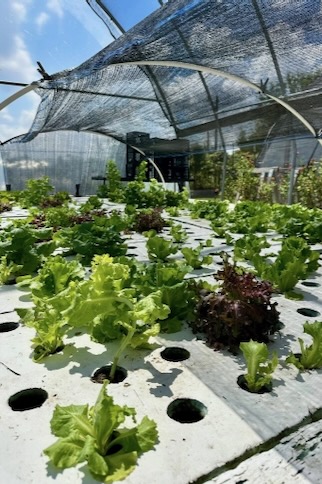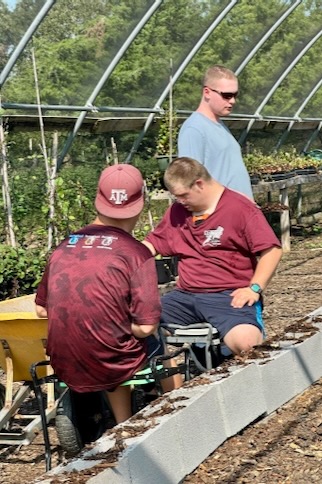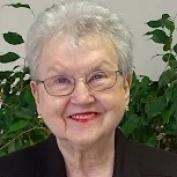
At GrowOn at AGFarm in Bryan, Texas, volunteer workers with disabilities enjoy a sense of productivity.
A sustainable farm in Bryan, Texas is not only growing healthy vegetables, it’s helping individuals with disabilities grow mentally and physically.
In 2013, Sharon Wells, owner of GrowOn at AGFarm, started an aquaponics farm.
Her interest in growing fresh vegetables started the year before, after she had some health problems and wanted to eat a cleaner diet.
Wells, a Texas A&M graduate of Texas in math and special education teacher, says that while homeschooling her daughters, they attempted to grow a garden but miserably failed. Then she took up aquaponics.
“I researched aquaponics and set up a small system in our backyard. A business friend shared his aquaponics experience, and my father-in-law became interested, offering his property in Bryan, buying his first 32-foot-by-100-foot high tunnel greenhouse. We spent the winter/spring of 2012 researching/building our first system, which blossomed in August 2013,” she states.
ETHAN, THE FIRST AUTISM HELPER, STARTS WORK.

By the end of August 2013, a parent of an autism student, whom Wells spent seven-plus years teaching in Sunday School, phoned, asking, “Is there anything Ethan can do on your farm?”
Ethan had graduated from school, and the local opportunities that they thought would be available had not materialized. So he was watching videos and listening to music with very little outside interaction.
“Recognizing that there were multiple jobs at the farm that Ethan could be trained in, he started working at the farm in a very hot and sweaty August for less than one hour a week, grateful for the diet Dr. Pepper and time to sit in the cooler,” Wells said. “Now, he is at the farm almost every day.”
Wells said her first love is teaching people with disabilities.
“While in high school in Cairo, Egypt, I volunteered to help at an orphanage, wherein most of the children had various disabilities,” Wells said. “Later, as a public-school teacher, I worked with several students who had learning disabilities. I also taught Sunday School at our church for people with disabilities.”
WHAT THEY GROW

Today, GrowOn, Wells 2.5-acre aquatic farm, is located at 2861 FM 974 in Bryan.
“Although we grow more food than those with five or more acres, we don’t qualify for an agricultural exemption,” she says.
The vegetables she grows on the farm include various greens, including lettuce, kale, Swiss chard, celery, mustard greens, basil, spinach, and green onions. Over the years, several in-ground grow beds were installed to grow tomatoes, green beans, snap peas, cauliflower, broccoli, cabbage, beets, onions, green onions, various peppers, Malabar Spinach, asparagus, okra, watermelon, strawberries, cucumbers, zucchini, yellow squash, butternut squash, aloe vera, multiple herbs, along with wildflowers. Additionally, there are several beds with blackberries and figs. There are also several varieties of trees, including avocado, moringa, chaya, goji berries, peach, pear, apple, and lemon.
ENVIRONMENTALLY FRIENDLY METHODS
No synthetic fertilizers, insecticides, or herbicides are used on vegetables.
Only fish emulsion is used to fertilize GrowOn at AGFarm’s in-ground beds. The farm was organically certified by California Certified Organic Farmer (CCOF) for the first few years (Texas would not certify an aquaponics system).
“We dropped the certification when the cost became $2,500/year, and I became disgruntled with the system. I was paying not to put anything on our produce, while farmers who were spraying their produce did not have to tell anyone what they were using. Other than purchasing high-quality fish food, the only thing we add to our aquaponics system is rainwater,” Wells said.
Although GrowOn at AGFarm is no longer organically certified, no compromises are made regarding the quality of the produce. To help build good-quality soil for in-ground planting, a local tree cutting company brings shredded materials to the farm for mulching in-ground beds.
“We still have approximately one acre of unused land due to poor soil quality. We plan to lightly till the area, lay down brown cardboard pieces, cover with wood mulch, scatter cover seeds, and water well. Prayerfully, we will have more fertile soil sometime next year. Also, to help in having good, fertile soil year-round, a compost pile is in the works,” she adds.
HOW AQUAPONICS WORK AND THE ROLE THAT THE FISH PLAY.
GrowOn at AGFarm’s fish are fed high-quality fish food, along with healthy roots harvested from the system. The fish excrete waste into the water, as well as excrete ammonia through their gills. The waste decays into ammonia, which serves as the basis for everything that happens in the rest of the system. Bacteria in the system eat ammonia and turn it into nitrite, a nitrogen compound. Then, different bacteria metabolize the nitrite, turning it into nitrate, a different nitrogen compound. Both ammonia and nitrites are toxic to the fish, but nitrates are not. All three act as fertilizers to plants on floating rafts in troughs, the second phase of the system.
Plants mature quickly, then are harvested, removing ammonia, nitrite, and nitrate from the system. New seedlings/plants are introduced soon to replace harvested ones, and the system continues indefinitely. Plants clean the water for the fish, and the fish provide fertilizer for the plants. Therefore, the system is self-balancing, recirculating, and only requires fish food, aeration, and pumping to maintain the cycle. Since plants in the system are housed in greenhouses, year-round harvests take place.
In 2014, Wells’ aquaponics farm was expanded with the addition of a second system and an in-ground greenhouse. Additionally, multiple in-ground beds and trees were installed after 2017.
The entire farm does not use aquaponics. Many seeds are started in the aquaponics system and then transplanted where they will grow.
YEAR-ROUND OPERATIONS
GrowOn at AGFarm operates year-round and is not climate-controlled. Planting/growing is adjusted to the time of year.
Workers are also trained to work in commercial kitchens, where they juice grapes and blackberries, then process them into syrups and jellies. Some of the produce and herbs are dehydrated to make spices and to use in tinctures.
WHERE PRODUCE IS SOLD
Most produce is sold directly from the farm at the Market Store.
“We also participated in Feeding Texas – LFA Spotlight, https://www.feedingtexas.org/, a Food Bank grant program for a few years. And plans are to provide baskets/bags to local families through local CrossFit gyms,” Wells says.
WORKERS ARE VOLUNTEERS

Currently, every GrowOn at AGFarm worker is a volunteer. Monies from the Market Store and from renting the commercial kitchens pay bills. The goal is to become self-sustaining, generating enough money to pay all those who work on the farm.
On most workdays, about 80 to 90 percent of workers are disabled adults. Additionally, approximately 24 adults with disabilities work various shifts. Workers are trained to perform all physically demanding tasks, including preparing beds for growth, planting, watering, harvesting, cleaning kitchens and bathrooms, maintaining the display area, and working at the checkout area in the Market Store. Additionally, a few community volunteers contribute approximately three hours of their time per week, and a few parents/relatives work a few shifts per week.
TRAINING AND WORKING WITH DISABLED ADULTS
Wells says that training/working with adults with disabilities is like working with anyone else. Like others, they have strengths and weaknesses. At times, it can be challenging to determine what is necessary for a worker to succeed at a task. “Watching them grow and thrive is very rewarding.
“Most of them look at life differently – often, it’s refreshing and encouraging. Workers who seem to have the most to complain about usually don’t complain.
“I’m sure that they teach me more than I teach them.”
Workers are local to Bryan.
Several workers have learned to use the Bryan transportation system.
WELLS CHALLENGES WORKERS MENTALLY AND PHYSICALLY
Wells challenges her workers and sets high expectations, never asking them to work on one task for an extended period. “I believe in working the brain and body to try new skills, challenging many of the workers. Often, after a worker has tried something ‘new’ for a while, they share that it is now something they enjoy doing,” she notes.
“Over the past decade, I have learned much. If I had known that growing food was so challenging (heat waves, drought, freezing temperatures, pests, maintenance problems, etc.), I probably wouldn’t have complained about food prices. Working through challenges has not only made us stronger but also more cohesive as a community. We are proud of our accomplishments and willing to share them with others,” she says.
